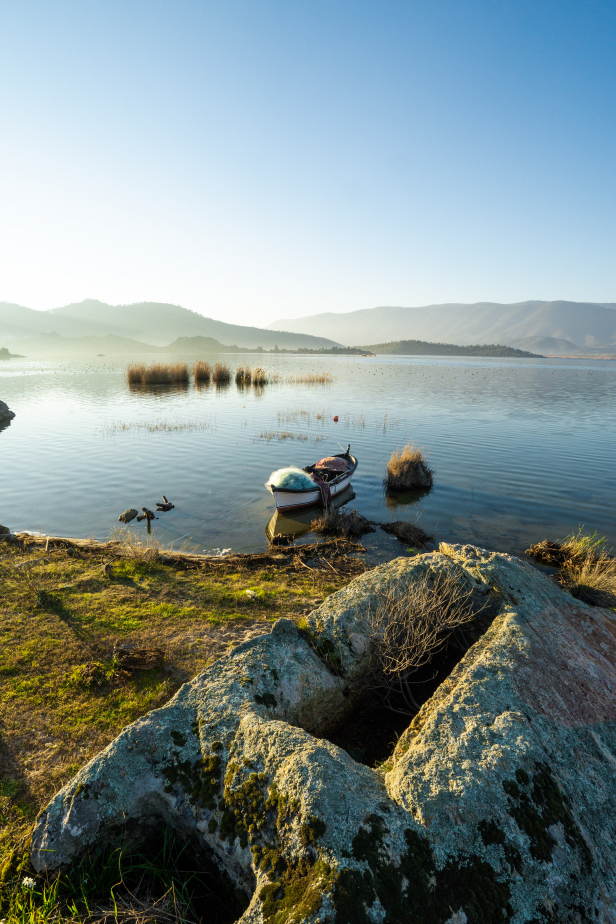Bafa Lake, Monasteries of Mount Latmos, and Ancient Herakleion
Bafa Gölü, Latmos Manastırları, ve Herakleion Antik Kenti
/ By Josh
Cost: Free
(There is a ticket booth at the Bafa Lake beach at Kapıkırı though it appears to be abandoned)
Great for: Neolithic History, Cave Paintings, Greek History, Byzantine History, Monasticism, Hiking, Bouldering
While the region around Bafa Lake and Mount Latmos are far less popular than sites like Ephesus, Heirapolis, Pergamum, and Aphrodisias, Bafa is quite possibly the richest and most varied collection of sites in western Turkey. From prehistoric rock paintings to island monasteries, from the ruins of ancient Herakleion to the quaint village life of Kapıkırı this region has plenty to offer historians, rock climbers, hikers, and even people who just want a quiet get away on a sandy beach at the foot of the mysterious Mount Latmos.
Now known as the Beşparmak (Five-Finger) Mountains, the environs of the ancient Mount Latmos have attracted people and mysticism for millennia. Mount Latmos sits to the east of Bafa Lake like a towering jumble of boulders; full of fissures and caves, many of the rocks eroded into strange shapes like breaking waves, or mushroom caps. Prehistoric settlers painted images of men and women, ancient civilizations built sanctuaries to storm gods, the early Greeks believed the moon goddess descended to this site to meet her lover, and medieval Christians chose the caves, islands, and high crags to build a dozen monasteries in this strange landscape.
Today the Bafa Lake and Beşparmak Mountain are home to small villages and vast olive groves that fill nearly all the cultivatable land between the great boulders and the lake shore. Olive cultivation here goes back thousands of years, an art that has continued despite the coming and going of different people and cultures.
Subscribe to The Art of Wayfaring
One of the most attractive places here is the village of Kapıkırı, built in the ruins of Herakleion overlooking the lake. The village is full of quaint hostels, set between temples, and farmhouses. In the morning, the streets are full of sheep and cows going out to pasture, while fishermen head out onto the lake. Despite the growing popularity of the area, it has managed to stay incredibly authentic and relatively unchanged all while offering necessary amenities to visitors.
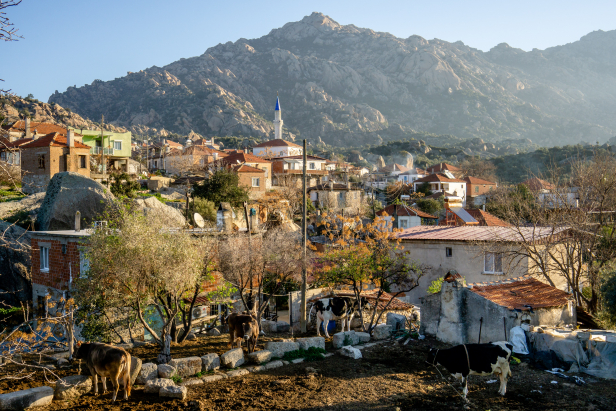
Amongst the ruins, woods, and streams, wild boar, porcupines, hedgehogs, and foxes are plentiful. In the spring when the lake is full the landscape is a brilliant green and full of wildflowers and the sound of honeybees.
Guidebook
Before getting into the history and specific sights of this incredible area, I need to recommend that you get Herakleia on The Latmos, an excellent guidebook by Anneliese Peschlow-Bindokat of the German Archaeological Institute. The maps, and detailed information are unparalleled, and it is impossible to truly explore this place deeply without it. While locals can be of some help, their knowledge of the histories and what specific sights are is quite spotty. I cannot recommend this book enough.
History of Bafa and the Latmos
While nearly all of Turkey can trace its story back to the prehistoric, there are few places with as much Neolithic evidence as Mount Latmos. There are hundreds of rock paintings here, hidden in the caves and undersides of the strange rocks that make up the mountain. The pre-agrarian peoples were attracted to the area for the natural shelter offered by the caves as well as the many fresh-water springs.
The territory around Mount Latmos changed hands frequently throughout its history. At Suratkaya in the eastern slopes of the mountain there is a small monument attesting to the Hittite Empire’s rule of the area, dated to the 2nd millennium BC. In Hittite records from this time the region was referred to as Karkija, a Hittite version of Caria. The old Carian city of Latmos was briefly ruled by the Lydians, then the Persian Empire in the 6th century BC. In the 3rd century BC the city of Latmos was abandoned and moved to a new grand city built directly on the shores of the bay, giving the city better access to sea trade. The new city was renamed Herakleia by the Carian king Mauselus, whose grand tomb was one of the seven wonders of the ancient world and the root for our English word ‘Mausoleum’. As there were many cities named for the god Heracles (Hercules), this Carian city was known as Herakleia on the Latmos.
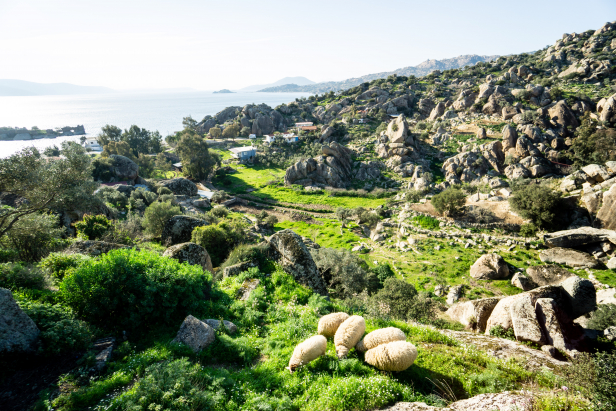
While the new city of Herakeia was built to a grand size, it quickly waned in influence, unable to compete with the other nearby cities who were given greater importance by the Romans. Herakleia’s fate was finally sealed in late antiquity when the sheltered bay that Herekleia was built on was cut off from the sea by the silt brought down out of the mountains by the River Meander (Büyük Menderes), turning the bay into a brackish lake. Unable to trade directly Herakleia dwindled, only ever filling a small portion of the massive space set by the massive walls.
During the Middle Ages the area around Mount Latmos was revitalized by an influx of Christian Monastics who founded monasteries on the high mountain slopes and islands. Many of the monks who settled here came from the famous desert monasteries of Egypt, driven out by Islamic persecutions on their communities. Towns and villages grew up along the lake shore and in the pasture lands and the Byzantines built castles and watchtowers throughout the area to protect the area from the Advancing Turks.
(If you are hoping to research the monasteries here it’s important to note that in ecclesiastical histories Latmos is referred to as Latros.)
Two of the most famous monks of the Latros Monastics are St Paul the Younger, also known as St Paul the Wonder Worker who lived there in the 10th century, and St Christodoulos Latrinos, who was born in Nicaea and entered the monastic life in Bithynian Olympos (Uludağ) and went on to found the monastery on the Island of Patmos where St John received his vision of Revalation.
In the 13th century the Byzantine communities of the Latros (Latmos) had to be abandoned in the face of the advancing Turks. Under Turkic rule the area was more or less abandoned, the only significant structure being the humble Caravanserai built on the southern shore of Bafa Lake.
Why Visit?
Herakleia
The city of Herakleia was founded on a massive scale, though the city never managed to fill the generous space set out by its 6.5 kms of fine walls. As the city is quite broad some of these sites are fairly scattered, though all are roughly centered on the village of Kapıkırı, built among the ruins of the Hellenistic city.
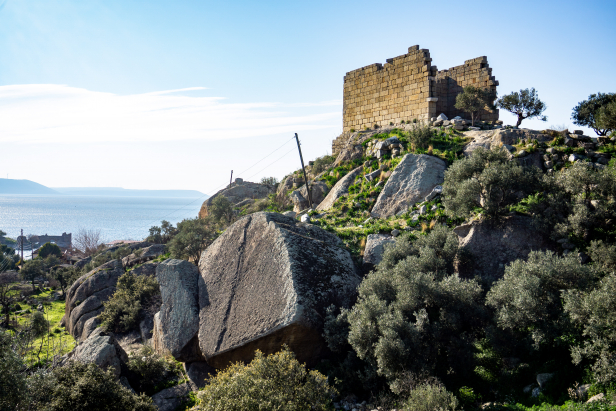
Standing prominent above the ruins and modern village alike is the Temple of Athena, a classically designed, doric, prostylos temple set atop a steep rocky crag. The temple is believed to have been built in the 3rd century, in the same period as the city itself.
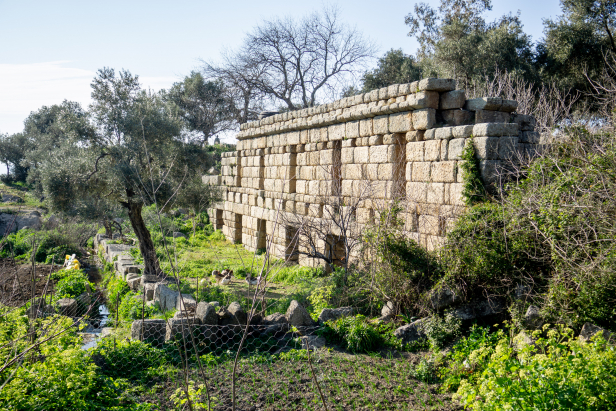
In front of the Temple of Athena is a wide flat space now occupied by large trees and a small schoolhouse. This flat space is what remains of the Agora of Herakleia. The heavy stones of the retaining walls and some scattered architectural fragments are the only significant remains.
A short way up the street from the Agora and Temple of Athena, hidden in a private garden (though you can enter through the gate) are the remains of the Bouleterion, the council house of the city’s leaders. Today all that remains are a handful of fluted pillar-stumps, peaking through the greenery, chickens having now replaced the city elders.
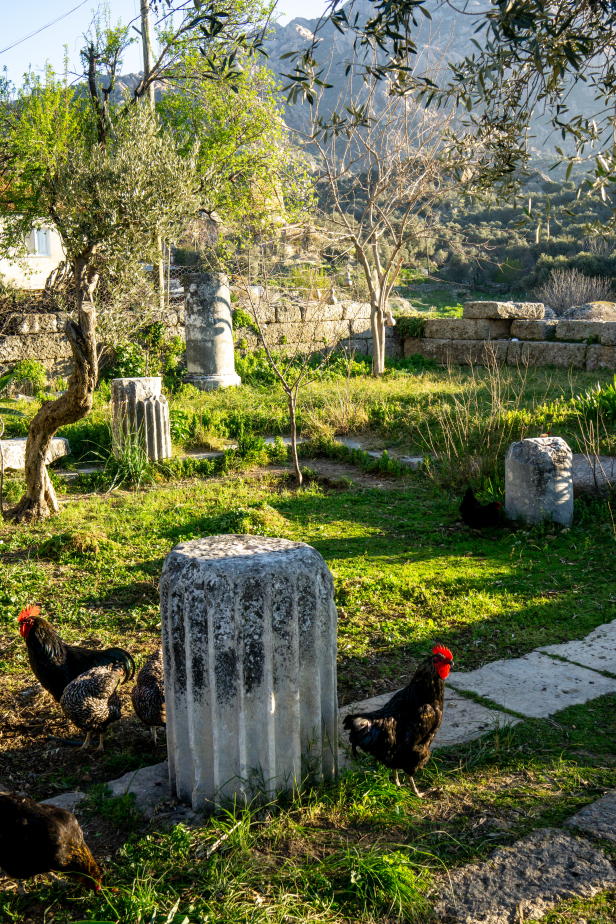
From here you can see the remains of the Roman Bath, a brick building in a state of near complete ruin.
Below the modern village, on the road heading down to the lake shore are the remains of the Temple of Endymion. The Temple of Endymion is one of Herakleia’s more unusual sites, historically significant, though not particularly impressive. Excavations in late 2021 have revealed a mosaic floor, and more finds are sure to come.
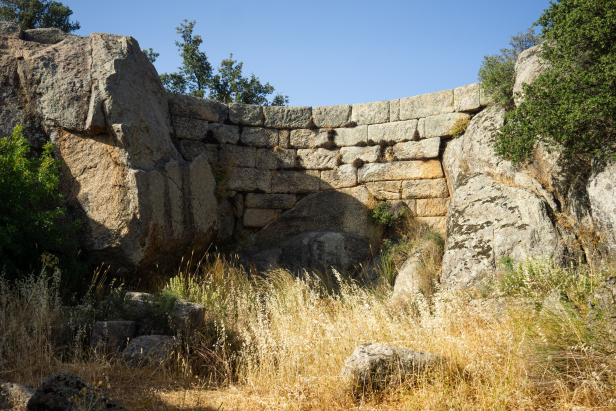
The exact story of Endymion, who is regarded as the legendary founder of the city of Herakleia, is somewhat confused. In one version of the story the moon goddess Selene falls in love with the handsome Endymion and asks Zeus to grant Endymion eternal youth. In another, rather different version of events, Selene falls in love with Endymion and convinces Zeus to put the young man in an eternal sleep. Selene then goes on to have dozens of daughters with the sleeping youth.
While there may have been an older shrine dedicated to Endymion on this site, the remains we see today are from the Hellenistic period. The shrine is a semicircular court, fronted by pillars. The natural bedrock juts out of the back wall, perhaps a reference to the mythical cave where Endymion slept.
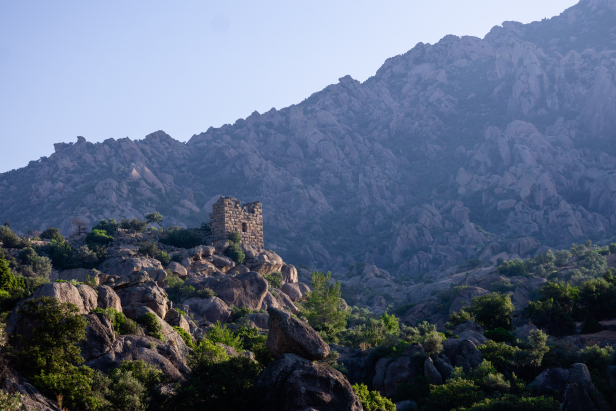
Stretching for 6.5 kilometers from the lake shore up onto the high shoulders of Mount Latmos, the Hellenistic Walls of Herakleia are particularly impressive. The remains on the north-west side of the city are in ruin, the stair like cuts in the steep rock indicating where the great blocks would have once been laid. On the eastern side of Herakleia the walls are in much better condition, with strong towers standing above the jumbled boulders and patches of green pasture.
Herakleia Castle
In the Byzantine period, the old walled city of Herakleia was far too large from the small population and so the center of defence was moved south onto a narrow headland jutting into the lake. The Byzantine Castle is built using small coarse stones and brick with heavy mortar, in sharp contrast to the massive, mortarless masonry of the Hellenistic era buildings. Excavations have also begun here in 2021.
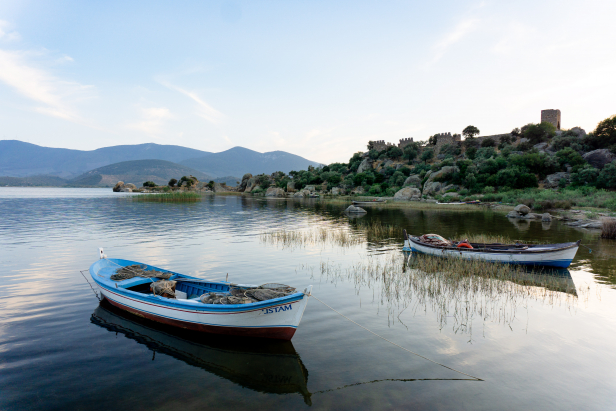
Necropolis
Just below Herakleia Castle you can see numerous graves cut into the rock, rectangles cut irregularly into almost every bit of exposed bedrock. Rock cut graves can be found all around the city covering a great distance. The majority of these were capped with heavy triangular lids, many of which can still be found moved just far enough from the grave to allow looters access to the treasure inside. There are over 200 graves in the immediate area around the city. The graves close to the waters edge have become convenient storage containers for locals who used them to store fishnets and jugs of fuel.
Carian City of Latmos
Just to the east of Herakleia (and modern Kapıkırı) is the old Carian city of Latmos that was abandoned around 300 BC. While this site was settled for centuries there is little of the old settlement remaining today. Initially much of the old Carian city was dismantled to build the new city, and centuries later the site was used as a monastery, making for a rather confused blend of eras. The Carians built their settlement using the natural boulders and cliffs, establishing homes between them; the slits where rooflines connected with the natural rock still visible in a number of places.
More about the Monastery in Carian Latmos Below.
Neolithic Paintings
Without a doubt the Latmos is one of Turkey’s richest areas for Neolithic history. With literally hundreds of stone age paintings depicting human figures and simple geometric patterns adorning caves, and rocky over hangs, the Latmos is a treasure trove of stone age art. The paintings depict men, voluptuous women, family units, hands, and zig-zags painted in red. To find these Neolithic paintings you will need to either hire a guide or use the detailed maps found in the Herakleia on The Latmos guidebook.
Subscribe to The Art of Wayfaring
Monasteries of the Latros
The Latros (medieval version of Latmos) is one of the richest areas in Turkey for monastic history. Numerous monastic communities and hermitages were established here, hidden among the crags, boulders, and island. According to the church histories these monasteries were well established with libraries, numerous monks, and beautiful fresco-adorned ceilings. One of the most well known is Yediler Monastery, set on a high slope above the village of Gölyaka. Yediler Monastery, a Turkish name meaning “Seven Monasteries” is likely the Kellibara Monastery. Today it is one of the easiest to access, with a few kilometers of well-marked trails leading from the village up to the monastery ruins. One of the greatest attractions to Yediler Monastery is the Yediler Cave, a rock shaped like a breaking wave, with the underside covered in a fresco depicting the life of Christ in a series of panels.

In the ruins of old Carian Latmos is a sight known as the Pantokrator Cave, named for a fresco depicting Christ Pantokrator on the small domed ceiling.
Near the top of Mount Latros is the site known today as Arap Avlu, meaning “Courtyard of the Arab”, quite likely the famed Byzantine Stylos Monastery associated with the monk Christodoulos Latrinos, who established a library here.
Many of these monasteries were hidden, built on islands, or protected by stone walls, all hinting at the threat of the Seljuk raids which eventually drove these communities out of the Latros and into Greece and onwards.
Bafa Lake and Islands
While the alien mountain landscape and stunning history of the area sets the Latmos apart, most people who visit the area come for the sake of Bafa Lake with its quiet shores and views of ruin-covered Islands. The saline waters attract migratory birds such as flamingos and pelicans, as well as local populations of hawks, owls, and dozens of little birds that flit among the reeds and olive trees. In spring and early summer the lake waters are clean and cool, but thanks to the surrounding farms, slow flowing water, and evaporation the water turns brackish and begins to smell by mid summer.

There are a number of islands in Bafa Lake, the best known being the ruin-covered Kapıkırı Island directly opposite the village of the same name. While you can swim to Kapıkırı and Kahve Asar Island, you may want to hire a boat to reach the others. Menet Island is the largest and was home to a sizable community with chapels and homes. Kahve Asar had a large church as well as some smaller chapels, still in decent condition. İkiz Island was home to a fortified monastery. Beyond these there were other lesser islets, some of which were home to small chapels and or hermitages.
For more specific information on which Island is which and what exactly can be found there I would again point you to the Herakleia on The Latmos guidebook (see link below).
Hiking and Climbing
The strange shaped boulders that make up the slopes of Beşparmak Mountain and line the shores of Bafa Lake have made it an excellent destination for rock climbers and boulderers. With rock towers and faces in the village, on the beaches, and up the mountain, the only issue is figuring out where to climb first.
There is an excellent guide to bouldering in the area called Bafa Gölü Bouldering by Zorbey Aktuyun that lays out various climbing spots and gives advice regarding all the practicalities of climbing and staying around Bafa Lake, the only issue is that it isn’t easy to find.

Also taking advantage of the stunning natural beauty is one of Turkey’s major long distance hiking routes. The Carian Way is an 800 km long network of trails that snakes its way along the beaches, mountains, forests, and ancient cities of Caria. In the area around Lake Bafa and the Latmos, the trail follows the ancient mountain highways built to connect Herakleia with other Carian cities such as Euromos and Miletus.
For more information, practicalities, and maps check out the official Carian Way Guidebook put together by the Cultural Routes Society.
Kadıkalesi and other Byzantine Forts and Castles
During the Middle Ages Byzantine control over the area was heavily contested with Turkish forces pushing from the interior. To ward off this threat the Byzantines built a series of castles and forts, strung out throughout the area. At the eastern end of the lake you can see the ruins of one such castle between the eastern end of Bafa Lake and the village of Bafa, known today in Turkish as Kadı Castle. Much of the walls still stand though the interior, like the hills surrounding, has been turned into an olive grove.
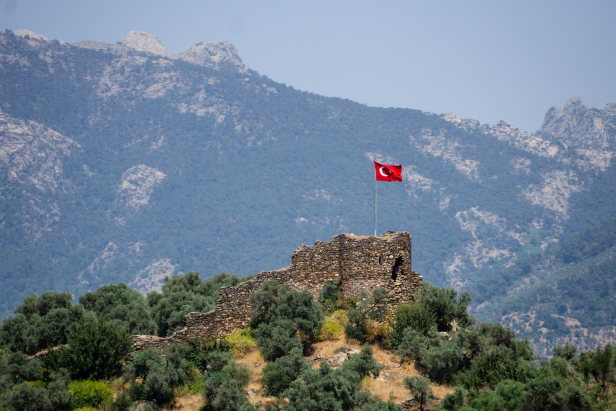
A short distance from the north-west tip of the lake you can visit the remains of another Byzantine castle, built atop the remains of the classical city of Myos.
Along the north shore of Bafa lake there are a handful of Byzantine tower-forts, the remains of which are overgrown and hard to access, though obvious from the lake.
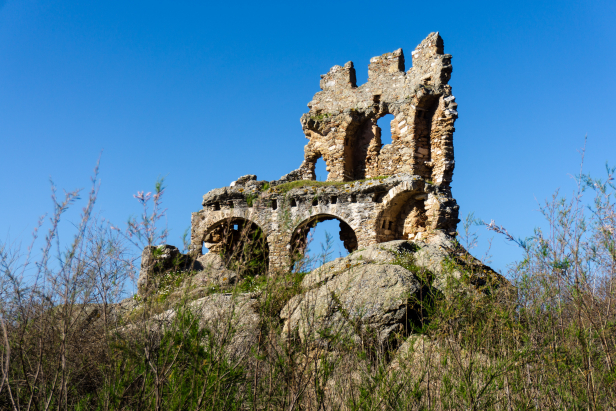
How To Get There
General
Bafa Lake and Mount Latmos (Beşparmak Dağı) straddle the Border of Muğla and Aydın provinces.
Public Transport
There is semi-regular bus service to the Village of Bafa from Milas in the south-east, and from Akbük/Didim from the west. These will take you as far as Bafa, from there to Kapıkırı (where the majority of the sites are) is another 8.5 kms. You’ll either have to walk this or catch a ride with a local passing by.
Car
To get to Bafa and Kapıkırı by car head west out of the city of Aydın, then turn left (south) on the D525 highway (İzmir-Söke highway) towards Didim. Rather than exiting to Didim, stay on the highway towards Milas. Passing by Bafa Lake on your left you’ll reach the village of Bafa. At the entrance to the village turn left following signs for Kapıkırı and Herakleia.
From Milas head north on the D525 (Milas-Söke). The highway will take you to the village of Bafa. Once you’ve passed through the village, turn right, following the signs for Kapıkırı and Herakleia.
For more about driving and renting in Turkey check out our complete Drivers Guide.
Other Tips
There are some small markets in the villages of Kapıkırı and Gölyaka, Bafa has quite a few more options but if you still can’t find what you’re looking for you may need to go to Didim.
While this has been stated a few times above, I can’t stress enough how valuable the Herakleia on The Latmos guidebook really is. Homer Kitabevi Publishers is an excellent source for unparalleled guides to archaeological sites.
Planning on visiting Bafa Lake and Mount Latmos? Make sure to check out nearby Euromos and our other sights in the region!
Subscribe to The Art of Wayfaring
Have any tips or info to add? Spot any mistakes? We’d love to hear about it.

